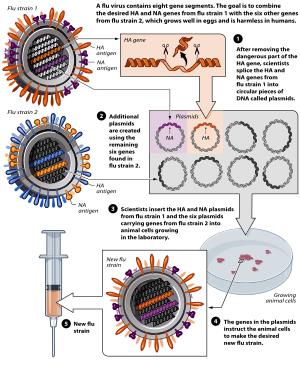Reverse genetics
[1] Reverse genetics systems can also allow the recovery and generation of infectious or defective viruses with desired mutations.
In order to learn the influence a sequence has on phenotype, or to discover its biological function, researchers can engineer a change or disrupt the DNA.
There are several different methods of reverse genetics: Site-directed mutagenesis is a sophisticated technique that can either change regulatory regions in the promoter of a gene or make subtle codon changes in the open reading frame to identify important amino residues for protein function.
[5] In the case of the plant model system huge mutant libraries have been created based on gene disruption constructs.
RNAi acts by directing cellular systems to degrade target messenger RNA (mRNA).
[10] The ability to analyze the loss-of-function phenotype allows analysis of gene function when there is no access to mutant alleles.
[11] While RNA interference relies on cellular components for efficacy (e.g. the Dicer proteins, the RISC complex) a simple alternative for gene knockdown is Morpholino antisense oligos.
Morpholinos are effective in systems ranging in complexity from cell-free translation in a test tube to in vivo studies in large animal models.
[citation needed] A molecular genetic approach is the creation of transgenic organisms that overexpress a normal gene of interest.
This might be due to removing a regulatory domain or mutating a specific amino residue that is reversibly modified (by phosphorylation, methylation, or ubiquitination).
Vaccines can be created by engineering novel genotypes of infectious viral strains which diminish their pathogenic potency enough to facilitate immunity in a host.
This produces a viral strain that is still live, but not pathogenic to humans,[13] as these viruses are rendered defective in that they cannot replicate their genome enough to propagate and sufficiently infect a host.
However, the viral genes are still expressed in the host's cell through a single replication cycle, allowing for the development of an immunity.
[14] A common way to create a vaccine using reverse genetic techniques is to utilize plasmids to synthesize attenuated viruses.
[12] This cDNA can then be inserted between an RNA polymerase I (Pol I) promoter and terminator sequence through restriction enzyme digestion.

